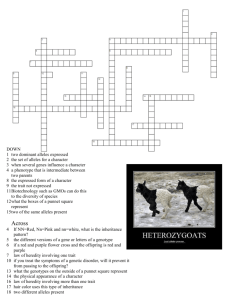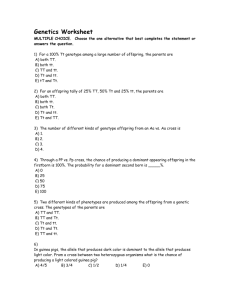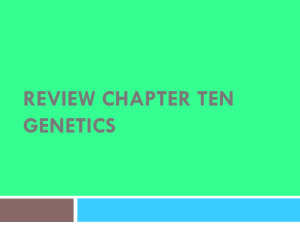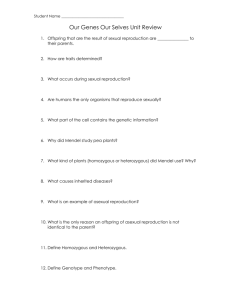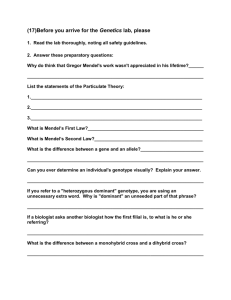MONOHYBRID and DIHYBRID PRACTICE PROBLEMS
advertisement
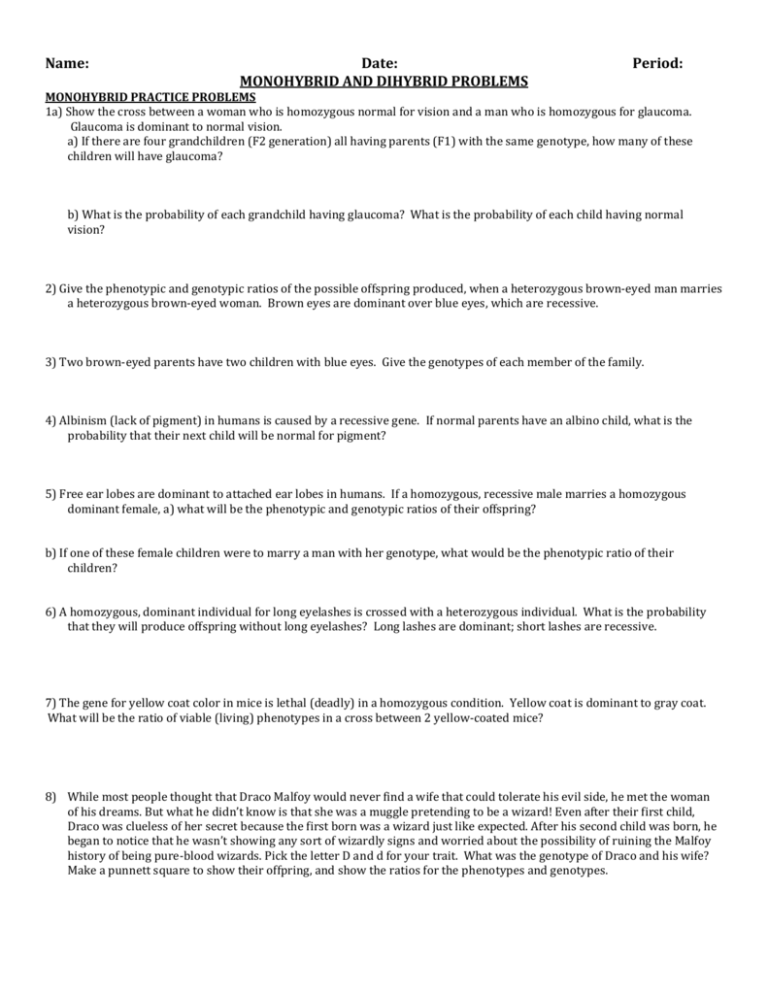
Name: Date: MONOHYBRID AND DIHYBRID PROBLEMS Period: MONOHYBRID PRACTICE PROBLEMS 1a) Show the cross between a woman who is homozygous normal for vision and a man who is homozygous for glaucoma. Glaucoma is dominant to normal vision. a) If there are four grandchildren (F2 generation) all having parents (F1) with the same genotype, how many of these children will have glaucoma? b) What is the probability of each grandchild having glaucoma? What is the probability of each child having normal vision? 2) Give the phenotypic and genotypic ratios of the possible offspring produced, when a heterozygous brown-eyed man marries a heterozygous brown-eyed woman. Brown eyes are dominant over blue eyes, which are recessive. 3) Two brown-eyed parents have two children with blue eyes. Give the genotypes of each member of the family. 4) Albinism (lack of pigment) in humans is caused by a recessive gene. If normal parents have an albino child, what is the probability that their next child will be normal for pigment? 5) Free ear lobes are dominant to attached ear lobes in humans. If a homozygous, recessive male marries a homozygous dominant female, a) what will be the phenotypic and genotypic ratios of their offspring? b) If one of these female children were to marry a man with her genotype, what would be the phenotypic ratio of their children? 6) A homozygous, dominant individual for long eyelashes is crossed with a heterozygous individual. What is the probability that they will produce offspring without long eyelashes? Long lashes are dominant; short lashes are recessive. 7) The gene for yellow coat color in mice is lethal (deadly) in a homozygous condition. Yellow coat is dominant to gray coat. What will be the ratio of viable (living) phenotypes in a cross between 2 yellow-coated mice? 8) While most people thought that Draco Malfoy would never find a wife that could tolerate his evil side, he met the woman of his dreams. But what he didn’t know is that she was a muggle pretending to be a wizard! Even after their first child, Draco was clueless of her secret because the first born was a wizard just like expected. After his second child was born, he began to notice that he wasn’t showing any sort of wizardly signs and worried about the possibility of ruining the Malfoy history of being pure-blood wizards. Pick the letter D and d for your trait. What was the genotype of Draco and his wife? Make a punnett square to show their offpring, and show the ratios for the phenotypes and genotypes. GAMATE PRACTICE PROBLEMS List all the gametes that are possible with each of the following genotypes. a. Aabb ___________________________ d. AABb ____________________________ b. AaBB ___________________________ e. AAbb ____________________________ c. AaBb ___________________________ f. aabb ____________________________ PROBABILITY PRACTICE PROBLEMS What is the probability of each of the following sets of parents producing the given genotypes in their offspring? Parents Genotype Offspring Genotype Probability Aa x Aa Aa Aa x aa Aa AaBb x AaBB AABB AaBb x AABb aabb AaBb x AaBb AaBb DIHYBRID AND MULTICHARACTER PRACTICE PROBLEMS MendAliens are from the plant LaneTechius. In MendAliens, black eyes are dominant to orange eyes. They usually have green skin, which is dominant but they can have white skin. Some MendAliens are 4 feet tall, which is dominant to being 2 feet tall. Four eyes is dominant to having 2 eyes and straight horns are dominant to curly horns. 1. Sam, a MendAlien with black eyes and green skin, has a parent with orange eyes and white skin. Carole is MendAlien with orange eyes and white skin. If Sam and Carole were to mate, what are the phenotype probabilities of their offspring? 2. Matthew the MendAlien is heterozygous for horn shape and height. He marries and mates with Mandy, who is also heterozygous horn shape and height. a. What is the possibility that their offspring will be tall with curly horns? b. What is the possibility that their offspring will be tall with straight horns? c. What is the possibility that their offspring will be short with curly horns? d. What is the possibility that their offspring will be short with straight horns? e. What is the possibility that their offspring will have the same genotype as the parents? f. What is the possibility that their offspring will have a recessive genotype for horn shape but be heterozygous for height? 3. In a cross AaBbCcDd AaBbCcDd, a. what is the probability of producing the genotype that is identical to the parents? b. what is the probability of producing an offspring with a homozygous recessive for all genes? c. Assuming complete dominance, what is the probability of producing the phenotype that is identical to the parents? 4. Determine the results of a cross between two tomato plants. One is heterozygous dominant for fruit color and height and the other is heterozygous for both traits. Red (R) is dominant to yellow (r) fruit color and tall height (T) is dominant over the dwarf variety (t). List all genotypes and phenotypes for the F1 generation In humans, right-handedness (R) is dominant to left-handedness and hitchhiker thumb (H) is dominant to straight thumb. 5. Chuck is homozygous right-handed and has a hitchkiker’s thumb. His father has a straight thumb. Emily is lefthanded and can’t bend her thumb back. a. What are the phenotype possibilities if Chuck and Emily have children? b. What is the probability that their baby’s genotype will be like: i. Chuck? ii. Emily? 6. Courtney is heterozygous for right-handedness and heterozygous hitchhiker thumb. She marries Steven, who has the same phenotype as Courtney. Steven’s mother, however, is left-handed and has a straight thumb. a. What are the phenotype possibilities if Courtney and Steven have children? b. What is the probability that their baby’s genotype will be: i. the same as Courtney? ii. the same as Steven? iii. pure-breed for right-handedness and hitchhiker thumb? 7. In horses, black is a dominant trait (B), chestnut is recessive (b). The trotting gait is dominant (T), pacing is recessive (t). a. If a homozygous black pacer is mated to a homozygous chestnut trotter, what will be the appearance of the F1 generation? b. If two F1 individuals were mated, what types of offspring could they have and in what ratios? Dihybrid Short Cuts 8. When a heterozygote is crossed with another heterozygote, what is the phenotype ratio for a: a. Monohybrid cross? b. 9. Dihybrid cross? Black feet in mice (B) is dominant to white feet (b) Short noses (N) are dominant to long nose (n). What fraction of the progeny of the cross BbNn BBnn will have black feet and long noses? 10. A male mouse that is heterozygous for black feet and a short nose is mated with a female mouse, which has black feet and a short nose. The female mouse has a mother, which is white feet and has a long nose. What fraction of the offspring will have a. black feet and short short? b. White feet and long nose? 11. Determine the results of a cross between two dolphins. One is heterozygous dominant for skin color and tail length and the other is heterozygous for both traits. Grey skin (G) is dominant to white skin (g) and long tails (T) are dominant over short tails (t). List all phenotype ratios for the F1 generation. 12. In summer squash, white fruit color (F) is dominant over yellow fruit color (f) and disk-shaped fruit (D) is dominant over sphere-shaped fruit (d). If a squash plant true-breeding for white, disk-shaped fruit is crossed with a plant truebreeding for yellow, sphere-shaped fruit, what can their offspring look like (the F1 generation)? 13. If you crossed two of the above F1 generation squash plants, what can the offspring of the next generation (the F2 generation) look like? The Challenge…. 14. In a cross AaBbCCDdEEff a. AABBCCDDEEFF b. AaBbCcddEEFf c. aabbCcDdEeFf AaBbCcddEeFF, what is the probability of producing the genotype For the questions listed below, you must show ALL of your work in order to prove your answer. 1. As we know, Mrs. Dursley and Lily Potter are sisters. Lily, as we mentioned earlier, is a wizard, but Mrs. Dursley lacks the wizardly trait. If this is true, what is the probability for each genotype if their muggle parents, Mr. and Mrs. Evans, had another child? Use the space provided to create any punnett squares necessary to solve the problem and fill in the genotypes and phenotypes of each individual below. Lilly Potter: G: P: Mrs. Dursley: G: P: Mrs. Evans: G: P: Mr. Evans: G: P: Probability for each Genotype: _____MM _____Mm ______mm 2. As we know, Hermione Granger is the best at performing the Wingardium Leviosa trait. Hogwart’s decided to test each student’s spell traits to see which were genetic, and found that Wingardium Leviosa was one. We also know that Neville Longbottom struggles casting many of spells. The tests revealed that Neville lacked many of the dominant genes necessary to be a successful wizard. If Hermione, who is dominant for the Wingardium Leviosa trait (WW), and Neville had a child, should they worry that their children will lack the trait like their father? Harry Potter Genetics (Dihybrid Cross) 1. The first time Professor McGonagall took everyone out for the broom-flying lesson, Neville lost control and broke his wrist. Turns out, there is a dominant trait (B) that allows better broom control and Neville does not have that trait. When Harry Potter made the amazing catch to save the remembrall, he discovered he was homozygous dominant for the broom control trait. Professor McGonagall then instantly thought, there is a good chance that Harry is also dominant for the seeker trait (S). After genetic testing, Harry found out he was heterozygous for the seeker trait and Neville was homozygous recessive for the seeker trait. What are the genotypes for Harry and Neville? What are the possible gametes for each person? (Hint: Use “foil”) 2. Two of Hagrid’s dragons produce offspring. Large wings are dominant to short wings and three toes is dominant to six toes. One dragon is heterozygous for the large wing trait (L) and has six toes. The other dragon has short wings and six toes. Create a dihybrid cross to determine what the chances are that they have a large wing dragon with three toes. Also, include genotypic and phenotypic ratios. 3. The dark wizard, Lord Voldemort, is able to speak parseltongue (pp), which is a recessive trait. Not only can he speak parseltongue, he can also do dark magic (dd). Him and his followers, the Death Eaters, spend a lot of time together practicing dark magic. Over the years, Voldemort and Bellatrix Lestrange fell in love. In order to continue their dream of taking over the wizarding world, they decided to have children. Bellatrix, who can do dark magic, cannot speak parseltongue. However, they only want children if they can speak pareseltongue as well. a. What is Voldemort’s genotype? b. What does Bellatrix’s genotype have to be in order to have a child who can do black magic and speak parseltongue? c. Create a dihybrid cross using Bellatrix’s genotype of part B, include genotypic and phenotypic ratios. d. What is the percent chance that they have a child who can speak parseltongue and do black magic?

